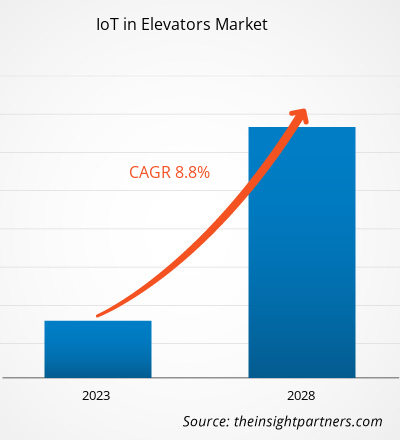[Rapporto di ricerca]Si prevede che il mercato dell'IoT negli ascensori crescerà da 35.415,87 milioni di dollari nel 2022 a 58.843,69 milioni di dollari entro il 2028; si prevede una crescita a un CAGR dell'8,8% dal 2022 al 2028.
Le piccole e medie imprese (PMI) e le grandi imprese fanno ampio affidamento su soluzioni intelligenti. L'adozione dell'IoT in queste aziende sta diventando sempre più diffusa, trainando la crescita del mercato dell'IoT negli ascensori. Inoltre, con la crescente concorrenza, molte aziende stanno investendo in modo significativo in soluzioni e servizi intelligenti. Pertanto, si aprono opportunità redditizie per i principali fornitori di IoT negli ascensori, poiché queste aziende si affidano sempre più alla salvaguardia e alla protezione dei propri beni da minacce interne o esterne. Molti governi stanno inoltre investendo in progetti di sviluppo urbano. Secondo il Ministero dell'Edilizia Abitativa e degli Affari Urbani, il governo indiano ha investito 160 miliardi di dollari nello sviluppo e nell'ammodernamento delle infrastrutture urbane dal 2014. Rispetto al periodo 2004-2014, gli investimenti dell'India nel settore urbano sono aumentati di oltre il 600% dal 2014 al 2021. Il governo indiano ha istituito un Piano Nazionale per le Infrastrutture (NIP) del valore di 1,5 trilioni di dollari per progetti infrastrutturali che dovrebbero essere completati tra il 2020 e il 2025.
Politiche favorevoli, iniziative e ingenti investimenti in città intelligenti e progetti di sviluppo urbano da parte di enti governativi e privati hanno creato opportunità redditizie per i principali attori che operano nel mercato dell'IoT negli ascensori. Inoltre, durante il periodo di previsione, si prevede che l'espansione economica e il crescente interesse per lo sviluppo di settori industriali verticali leader aumenteranno la domanda di IoT negli ascensori. Tuttavia, gli elevati investimenti iniziali necessari per la modernizzazione degli ascensori e le integrazioni IoT limitano la crescita dell'IoT nel mercato degli ascensori.
Personalizza questo rapporto in base alle tue esigenze
Potrai personalizzare gratuitamente qualsiasi rapporto, comprese parti di questo rapporto, o analisi a livello di paese, pacchetto dati Excel, oltre a usufruire di grandi offerte e sconti per start-up e università
IoT nel mercato degli ascensori: Approfondimenti strategici

- Ottieni le principali tendenze chiave del mercato di questo rapporto.Questo campione GRATUITO includerà l'analisi dei dati, che vanno dalle tendenze di mercato alle stime e alle previsioni.
Potrai personalizzare gratuitamente qualsiasi rapporto, comprese parti di questo rapporto, o analisi a livello di paese, pacchetto dati Excel, oltre a usufruire di grandi offerte e sconti per start-up e università
IoT nel mercato degli ascensori: Approfondimenti strategici

- Ottieni le principali tendenze chiave del mercato di questo rapporto.Questo campione GRATUITO includerà l'analisi dei dati, che vanno dalle tendenze di mercato alle stime e alle previsioni.
Impatto della pandemia di COVID-19 sulla crescita del mercato europeo dell'IoT negli ascensori
La pandemia di COVID-19 ha avuto un impatto grave sui paesi europei, tra cui Germania, Francia, Spagna e Italia. L'Italia è stata il paese più colpito durante il periodo post-pandemia. Prima della pandemia, si prevedeva una crescita significativa del mercato dell'IoT negli ascensori a causa della crescente domanda di prodotti e servizi a basso consumo energetico; della crescente adozione di piattaforme basate su IoT, soluzioni basate su cloud e intelligenza artificiale; e della crescente domanda di industrializzazione in ogni settore verticale.
L'industria elettronica è tra i settori più duramente colpiti in alcuni paesi europei. Tuttavia, nella seconda ondata dell'epidemia di COVID-19, il settore dell'elettronica e dei semiconduttori ha subito un impatto negativo. Nel 2021, con l'allentamento delle misure di lockdown, l'attività manifatturiera è ripresa. Pertanto, le prospettive per il mercato dell'IoT negli ascensori hanno acquisito slancio. Inoltre, nel 2022, si prevede che la domanda di IoT crescerà a causa dell'impennata nella costruzione di edifici commerciali e industriali. Pertanto, l'IoT nel settore degli ascensori ha beneficiato della pandemia. Nello scenario post-pandemico, l'adozione dell'IoT per la sostenibilità, il passaggio alle piattaforme cloud, le crescenti agevolazioni fiscali per cittadini e vari settori industriali verticali e l'accesso remoto sicuro rafforzeranno l'espansione del mercato dell'IoT negli ascensori.
Approfondimenti di mercato: il mercato dell'IoT negli ascensori
Il mercato globale dell'IoT negli ascensori, in base alla regione, è segmentato in Nord America, Europa, Asia-Pacifico (APAC), Medio Oriente e Africa (MEA) e Sud America (SAM).
L'Europa ha detenuto la maggiore quota di mercato dell'IoT negli ascensori nel 2021 e si prevede che dominerà il mercato anche durante il periodo di previsione. L'adozione del 5G e gli investimenti delle aziende nel miglioramento dell'infrastruttura 5G guidano la crescita del mercato nella regione. La Germania vanta una lunga tradizione di investimenti e innovazione nell'IoT industriale. Il Paese è inoltre leader nell'utilizzo del 5G per espandere l'uso dell'IoT industriale. La crescente domanda di sistemi di imaging industriale nel settore manifatturiero e di componenti avanzati per l'infotainment automobilistico, dispositivi di monitoraggio del conducente e unità di controllo del conducente nel settore automobilistico influenza ulteriormente la domanda di IoT negli ascensori nei settori manifatturiero e automobilistico. Anche la rapida crescita dell'edilizia nel settore commerciale in tutto il Paese sta aumentando la domanda di sistemi per ascensori basati su IoT. Questi fattori stanno stimolando la crescita dell'IoT nel mercato degli ascensori in Europa.
Nel 2020, il Nord America ha detenuto la seconda quota di mercato dell'IoT negli ascensori. Si prevede che il mercato negli Stati Uniti manterrà le sue solide prospettive di crescita durante il periodo di previsione. Negli Stati Uniti, l'aumento del reddito disponibile e il miglioramento del tenore di vita stimolano la domanda di elettronica intelligente. La domanda di dispositivi miniaturizzati è elevata grazie alla crescente popolarità dell'intelligenza artificiale e della rivoluzione industriale 4.0. Inoltre, molti produttori stanno investendo ingenti capitali nello sviluppo di sistemi di digitalizzazione dell'elettronica intelligente, come ad esempio per applicazioni di automazione delle infrastrutture. Il governo degli Stati Uniti ha intrapreso numerose iniziative per promuovere l'industria elettronica. Il 6 maggio 2022, il governo ha presentato una nuova proposta bipartisan negli Stati Uniti per alimentare il settore dei circuiti stampati (PCB) del Paese. Molte aziende affermate del settore della produzione di elettronica nel Paese hanno accolto con favore la proposta. Il disegno di legge supporterà il CHIPS Act del 2021 e l'American Printed Circuit Boards Act del 2022. Di conseguenza, ci sono molte opportunità redditizie per i principali operatori nel mercato dell'IoT negli ascensori.
Approfondimenti basati sui componenti
In base ai componenti, il mercato dell'IoT negli ascensori è segmentato in hardware, software e servizi. Il segmento hardware ha rappresentato il mercato più ampio nel 2021. La domanda di hardware è aumentata drasticamente negli ultimi anni. L'intelligenza artificiale viene utilizzata per aiutare operatori e appaltatori meccanici a tenere il passo con le loro routine quotidiane e a trovare modi per gestire il traffico degli ascensori e prevenire i problemi prima che si verifichino, sulla base dei dati raccolti dall'utilizzo quotidiano degli ascensori.
In base all'applicazione, il mercato dell'IoT negli ascensori è segmentato in manutenzione preventiva, monitoraggio remoto, diagnosi e previsione dei guasti, reporting avanzato e gestione della connettività. Il mercato dell'IoT negli ascensori, per utente finale, è segmentato in residenziale, commerciale e industriale. In base all'area geografica, il mercato è principalmente segmentato in Nord America, Europa, Asia Pacifico (APAC), Medio Oriente e Africa (MEA) e Sud America.
OTIS, Schindler Group, KONE Corporation, Hyundai Elevator Co., Ltd. e Fujitec sono tra i principali attori del mercato dell'IoT negli ascensori. Il mercato è altamente frammentato, con diversi attori localizzati in una specifica regione per soddisfare la domanda interna.
Approfondimenti regionali sul mercato dell'IoT negli ascensori
Le tendenze e i fattori regionali che hanno influenzato il mercato dell'IoT negli ascensori durante il periodo di previsione sono stati ampiamente spiegati dagli analisti di The Insight Partners. Questa sezione analizza anche i segmenti e la geografia del mercato dell'IoT negli ascensori in Nord America, Europa, Asia-Pacifico, Medio Oriente e Africa, America Meridionale e Centrale.
Ambito del rapporto di mercato sull'IoT negli ascensori
| Attributo del rapporto | Dettagli |
|---|---|
| Dimensioni del mercato in 2022 | US$ 35.42 Billion |
| Dimensioni del mercato per 2028 | US$ 58.84 Billion |
| CAGR globale (2022 - 2028) | 8.8% |
| Dati storici | 2020-2021 |
| Periodo di previsione | 2023-2028 |
| Segmenti coperti |
By Componente
|
| Regioni e paesi coperti | Nord America
|
| Leader di mercato e profili aziendali chiave |
|
Densità degli operatori del mercato IoT negli ascensori: comprendere il suo impatto sulle dinamiche aziendali
Il mercato dell'IoT negli ascensori è in rapida crescita, trainato dalla crescente domanda degli utenti finali dovuta a fattori quali l'evoluzione delle preferenze dei consumatori, i progressi tecnologici e una maggiore consapevolezza dei vantaggi del prodotto. Con l'aumento della domanda, le aziende stanno ampliando la propria offerta, innovando per soddisfare le esigenze dei consumatori e sfruttando le tendenze emergenti, alimentando ulteriormente la crescita del mercato.

- Ottieni il IoT nel mercato degli ascensori Panoramica dei principali attori chiave
Gli operatori che operano nell'analisi del mercato dell'IoT negli ascensori si concentrano principalmente sullo sviluppo di prodotti avanzati ed efficienti.
- A dicembre 2021, KONE, multinazionale produttrice di ascensori e scale mobili, ha stretto una partnership con Amazon Web Services (AWS), la piattaforma cloud più completa e utilizzata al mondo. AWS fornirà a KONE funzionalità cloud globali, tra cui Internet of Things (IoT) e analisi. Inoltre, le aziende collaboreranno per creare nuove tecnologie che miglioreranno la scalabilità e le prestazioni dei servizi e delle soluzioni connesse di KONE.
- Ad aprile 2021, Mitsubishi Electric Corporation ha annunciato che la sua controllata Mitsubishi Elevator India Private Limited (IMEC) ha ricevuto un contratto firmato per la fornitura di ascensori ai complessi di lusso Commerzone Madhapur e Altimus, di proprietà di K RAHEJA CORP, un rinomato costruttore indiano.
- Analisi storica (2 anni), anno base, previsione (7 anni) con CAGR
- Analisi PEST e SWOT
- Valore/volume delle dimensioni del mercato - Globale, Regionale, Nazionale
- Industria e panorama competitivo
- Set di dati Excel
Report recenti
Testimonianze
Motivo dell'acquisto
- Processo decisionale informato
- Comprensione delle dinamiche di mercato
- Analisi competitiva
- Analisi dei clienti
- Previsioni di mercato
- Mitigazione del rischio
- Pianificazione strategica
- Giustificazione degli investimenti
- Identificazione dei mercati emergenti
- Miglioramento delle strategie di marketing
- Aumento dell'efficienza operativa
- Allineamento alle tendenze normative






















 Ottieni un campione gratuito per - IoT nel mercato degli ascensori
Ottieni un campione gratuito per - IoT nel mercato degli ascensori